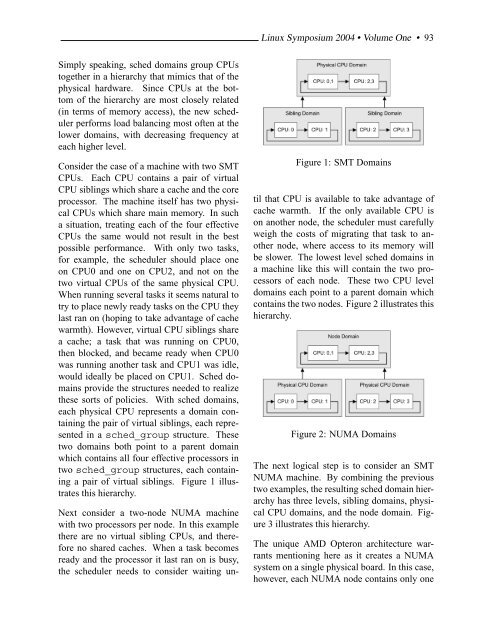You also want an ePaper? Increase the reach of your titles
YUMPU automatically turns print PDFs into web optimized ePapers that Google loves.
<strong>Linux</strong> Symposium 2004 • Volume <strong>One</strong> • 93<br />
Simply speaking, sched domains group CPUs<br />
together in a hierarchy that mimics that of the<br />
physical hardware. Since CPUs at the bottom<br />
of the hierarchy are most closely related<br />
(in terms of memory access), the new scheduler<br />
performs load balancing most often at the<br />
lower domains, with decreasing frequency at<br />
each higher level.<br />
Consider the case of a machine with two SMT<br />
CPUs. Each CPU contains a pair of virtual<br />
CPU siblings which share a cache and the core<br />
processor. <strong>The</strong> machine itself has two physical<br />
CPUs which share main memory. In such<br />
a situation, treating each of the four effective<br />
CPUs the same would not result in the best<br />
possible performance. With only two tasks,<br />
for example, the scheduler should place one<br />
on CPU0 and one on CPU2, and not on the<br />
two virtual CPUs of the same physical CPU.<br />
When running several tasks it seems natural to<br />
try to place newly ready tasks on the CPU they<br />
last ran on (hoping to take advantage of cache<br />
warmth). However, virtual CPU siblings share<br />
a cache; a task that was running on CPU0,<br />
then blocked, and became ready when CPU0<br />
was running another task and CPU1 was idle,<br />
would ideally be placed on CPU1. Sched domains<br />
provide the structures needed to realize<br />
these sorts of policies. With sched domains,<br />
each physical CPU represents a domain containing<br />
the pair of virtual siblings, each represented<br />
in a sched_group structure. <strong>The</strong>se<br />
two domains both point to a parent domain<br />
which contains all four effective processors in<br />
two sched_group structures, each containing<br />
a pair of virtual siblings. Figure 1 illustrates<br />
this hierarchy.<br />
Next consider a two-node NUMA machine<br />
with two processors per node. In this example<br />
there are no virtual sibling CPUs, and therefore<br />
no shared caches. When a task becomes<br />
ready and the processor it last ran on is busy,<br />
the scheduler needs to consider waiting un-<br />
Figure 1: SMT Domains<br />
til that CPU is available to take advantage of<br />
cache warmth. If the only available CPU is<br />
on another node, the scheduler must carefully<br />
weigh the costs of migrating that task to another<br />
node, where access to its memory will<br />
be slower. <strong>The</strong> lowest level sched domains in<br />
a machine like this will contain the two processors<br />
of each node. <strong>The</strong>se two CPU level<br />
domains each point to a parent domain which<br />
contains the two nodes. Figure 2 illustrates this<br />
hierarchy.<br />
Figure 2: NUMA Domains<br />
<strong>The</strong> next logical step is to consider an SMT<br />
NUMA machine. By combining the previous<br />
two examples, the resulting sched domain hierarchy<br />
has three levels, sibling domains, physical<br />
CPU domains, and the node domain. Figure<br />
3 illustrates this hierarchy.<br />
<strong>The</strong> unique AMD Opteron architecture warrants<br />
mentioning here as it creates a NUMA<br />
system on a single physical board. In this case,<br />
however, each NUMA node contains only one

















